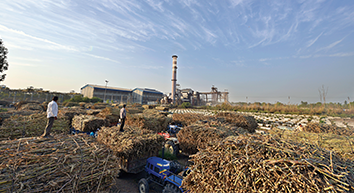Power Transmission Business achieved a turnover of ₹ 130.08 crore during the year, a decline of 15.6%, and segment profit of ₹ 40.9 crore, lower by 15.7% than the previous year. The total order booking, however, during the year was marginally higher than last year at ₹ 157.8 crore. The outstanding order book as on March 31, 2021 stood at ₹ 166.23 crore including long duration orders of ₹ 66.63 crore executable over a couple of years.
Impact due to COVID-19
The capital goods (comprising of power generating equipment, material handling equipment, furnaces, mining machinery, etc.) has borne the maximum adverse impact of the COVID-19 pandemic, which in turn has also affected the performance of PTB.
COVID-19 pandemic had posed unprecedented challenges in terms of delays, hold, travel restrictions, closure of plant / partial running, migration of labour across regions and these demanded intrinsic changes in business operations. As a result, the investments as well as existing projects were postponed by customers. PTB was forthright to get prepared in a shorter span of time for conducting negotiations, contractual resolutions and remote monitoring of product testing including online service support. This helped PTB to maximise turnover in the given scenario and aggressive push was given to maximise bookings.
While the domestic steel demand is expected to take some hit due to the ongoing second COVID-19 wave, production of the commodity is also expected to align itself temporarily to meet urgent Oxygen requirement for medical reasons and has returned back to normalcy. As a result, the second wave impact is expected to be significantly lower as compared to first wave.
Market Outlook
Steel, power, cement, telecom, coal and mining were some of the sectors that accounted for the bulk of the capex undertaken by both private as well as government players on the back of friendly GOI policies on infrastructure spending.
Coal-based power added 3.1 GW to total generation capacity in the eleven months to February 2021, taking its total installed capacity to 201 GW. India’s power demand is expected to rise to 1,905 TWh by FY 22 from current generation level of 1,558.7 TWh. The growth in infrastructure and real estate sector, post-COVID pandemic, is likely to augment the demand for cement in 2021. The industry is likely to add ~8 MTPA capacity in cement production. The industry could benefit with the pent-up demand phenomena as the economy has been on an unlock mode but on the flipside as the second wave of the contagion is hitting the economy, this could be a detriment to the entire demand-supply of the industry. With the rural markets normalising, the demand outlook remains strong.
The overall fertiliser production grew by 4-6% during FY 21. The country witnessed on-time arrival of Southwest monsoon, followed by a quick spread across the region, which has resulted in higher sowing, thus augmenting the sales of fertilisers, which has led to an increase in production. The Government is reviving 5 closed fertiliser plants which will have potential for gearbox replacement.
Under the new Petroleum, Chemicals and Petrochemicals Investment Region (PCPIR) Policy 2020-35, a combined investment of USD 142 billion is targeted by the year 2025 in all the PCPIRs across the country. PCPIR Gujarat has already attracted investments wherein various Indian and multinational companies have opened facilities. PCPIR Rajasthan is actively working towards brining investments from top global players which will open ample opportunities for new facilities.
India’s oil demand is projected to reach 10 million bpd by 2030, from 5.05 million bpd in 2020. The Government allows 100 percent Foreign Direct Investment (FDI) in upstream and private sector refining projects.
National Steel Policy 2017 had envisaged achieving up to 300 MTPA of production capacity by FY 31 from current level of 140 MTPA. The steel production in India in 2020, however, was down by 10%, to 97 MTPA, as against the ideal level of 110- 120 MTPA. Indian Japan Steel Dialogue is expected to boost the steel sector on total production and capacity expansion. The increased capital expenditure for infrastructure projects in Union Budget 2021-22 is likely to push up the demand for infrastructure in the country.
Paper industry was one of the most affected (during the pandemic) as educational institutes were shut down. Education is one of the big drivers for the paper industry in India. Paper and Paperboard market in India is expected to grow at CAGR of ~5% cumulatively from 2021-26 due to higher growth of food and beverages, cosmetics, and other industries in India. Paper consumption is forecasted to increase by 7.6% per year in the coming years.
Indian sugar mills’ output rose by nearly a fifth year on year to 27.76 million tonnes in the first six months of FY 21. The Indian sugarcane market is projected to reach a CAGR of 4.3% during 2020-25.
On the backdrop of contraction during FY 22, consistent with economic growth expected in the domestic and international markets, PTB expects smart growth not just from domestic market but further consolidation into exports. Combined with the overall demand growth and also strong orders in hand position at the end of FY 21 of ₹ 166.23 crore, PTB expects promising growth during FY 22.
2021 Triveni Engineering, All Rights Reserved

























 Power Transmission Industry Review
Power Transmission Industry Review